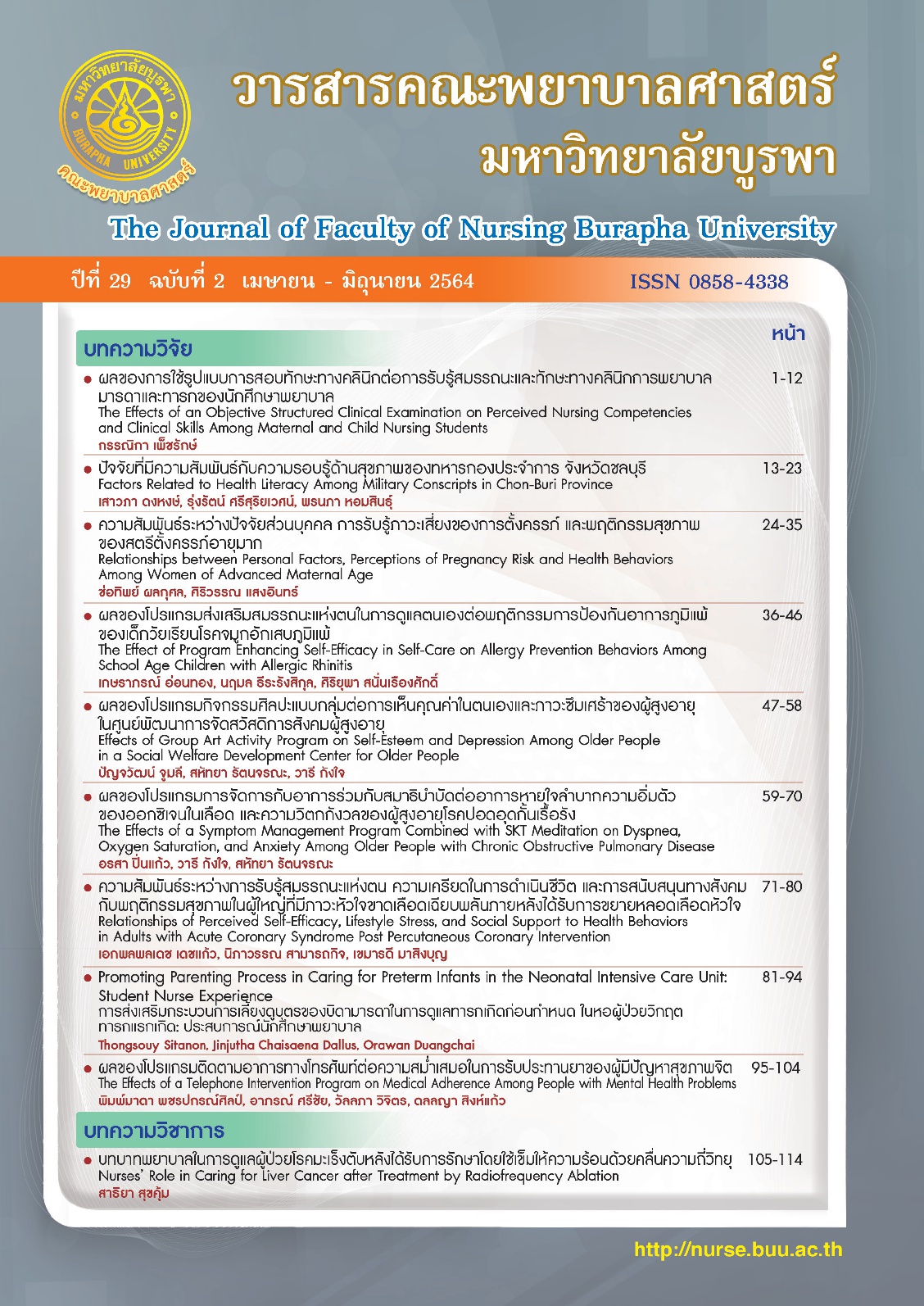ผลของโปรแกรมการจัดการกับอาการร่วมกับสมาธิบำบัดต่ออาการ หายใจลำบากความอิ่มตัวของออกซิเจนในเลือด และความวิตกกังวล ของผู้สูงอายุโรคปอดอุดกั้นเรื้อรัง
คำสำคัญ:
ผู้สูงอายุโรคปอดอุดกั้นเรื้อรัง, อาการหายใจลำบาก, ความวิตกกังวล, ความอิ่มตัวของออกซิเจนในเลือด, โปรแกรมการจัดการกับอาการบทคัดย่อ
การวิจัยกึ่งทดลองนี้มีวัตถุประสงค์เพื่อศึกษาผลของโปรแกรมการจัดการกับอาการร่วมกับสมาธิบำบัดต่ออาการ
หายใจลำบาก ความอิ่มตัวของออกซิเจนในเลือด และความวิตกกังวล กลุ่มตัวอย่างคือผู้สูงอายุโรคปอดอุดกั้นเรื้อรังที่รับ
การรักษาที่แผนกผู้ป่วยใน โรงพยาบาลแห่งหนึ่งในจังหวัดฉะเชิงเทรา สุ่มตัวอย่างแบบง่ายเข้ากลุ่มทดลอง และกลุ่มควบคุม
กลุ่มละ 22 คน กลุ่มทดลองได้รับโปรแกรมการจัดการกับอาการร่วมกับสมาธิบำบัด ส่วนกลุ่มควบคุมได้รับการพยาบาล
ตามปกติ เก็บข้อมูลในระยะก่อนการทดลอง หลังการทดลอง และติดตามผล 1 เดือน เครื่องมือวิจัย คือ แบบประเมิน
อาการหายใจลำบาก เครื่องวัดความอิ่มตัวของออกซิเจนในเลือด และแบบสัมภาษณ์ความวิตกกังวล วิเคราะห์ข้อมูลโดย
สถิติพรรณนาและสถิติวิเคราะห์ความแปรปรวนแบบวัดซ้ำ
ผลการวิจัยพบว่า กลุ่มทดลองมีค่าเฉลี่ยคะแนนอาการหายใจลำบาก และค่าเฉลี่ยคะแนนความวิตกกังวลในระยะ
หลังการทดลองและระยะติดตามผลน้อยกว่ากลุ่มควบคุมอย่างมีนัยสำคัญทางสถิติ (p < .05) และค่าเฉลี่ยคะแนน
ความอิ่มตัวของออกซิเจนในเลือดระยะหลังการทดลองและระยะติดตามผลมากกว่ากลุ่มควบคุมอย่างมีนัยสำคัญทางสถิติ
(p < .01) การวิจัยครั้งนี้มีข้อเสนอแนะว่า พยาบาลวิชาชีพควรนำโปรแกรมการจัดการกับอาการร่วมกับสมาธิบำบัด
ไปประยุกต์ใช้ในการพยาบาลผู้สูงอายุโรคปอดอุดกั้นเรื้อรังที่มีอาการหายใจลำบาก เพื่อบรรเทาจากอาการหายใจลำบาก
ความวิตกกังวล และเพิ่มระดับความอิ่มตัวของออกซิเจนในเลือด
เอกสารอ้างอิง
Dodd, M., Janson, S., Facione, N., Faucett, J., Froelicher, E., Humphrey, J., Lee, K., Miaskowski, C., Puntillo, K., Rankin, S., & Taylor, D. (2001). Advancing the science of symptom management. Journal of Advance Nursing, 33, 668-676.
Gift, G. A. (1989). Validation of a vertical visual analogue scale as a measure of clinical dyspnea. Rehabilitation Nursing, 14(6), 323-325.
Global Initiative for Chronic Obstructive Lung Disease [GOLD]. (2021). Global strategy for the diagnosis, management and prevention of chronic obstructive pulmonary disease. Retrieved from http://www.goldcopd.org/
Greer, J. A., MacDonald, J. J., Vaughn, J., Viscosi, E., Traeger, L., McDonnell, T., Pirl, W. F., & Temel, J. S. (2015). Pilot study of a brief behavioral intervention for dyspnea in patients with advanced lung cancer. Journal of Pain and Symptom Management, 50(6), 854-860.
Hehduereh, S., Balthip, K., & Thaniwattananon, P. (2018). The development of symptom management for dyspnea program In muslim elderly with chronic obstructive pulmonary disease. AL-HIKMAH Journal of Fatoni University, 8(15), 111-127. [In Thai]
Jitapunkul, S., Lailert, C., Worakul, P., Srikiatkhachorn, A., & Ebrahim, S. (1996). Chula mental test: A screening mental test developed for Thai elderly. International Journal Geriatric Psychiatry, 11, 715-20.
Jitrarat, N. (2017). The effect of symptom management combined with meditation practice on dyspnea in advanced lung cancer patients undergoing chemotherapy. Songklanagarind Journal of Nursing, 37(1), 24-37. [In Thai]
Kraemer, H. C., & Theimann, S. (1987). How many subjects: Statistical power analysis in research. Newbury Park, CA: Sage.
Long, J., Ouyang, Y., Duan, H., & Xiang, Z. (2020). Multiple factor analysis of depression and/ or anxiety in patients with acute exacerbation chronic obstructive pulmonary disease. International Journal of COPD, 15, 1449-1464.
Mind Garden Incoporation. (2018). State-Trait Anxiety Inventory for AdultsTM. Menlo Park, CA: Mind Garden.
Ngoenthae, D., Arpanantikul, M., & Duangbubpha, S. (2017). Self-care experience of people with chronic obstructive pulmonary disease (COPD) exacerbation. Thai Journal of Nursing Council, 32, 47-63. [In Thai]
O’Donnell, D. E., Milne, K. M., James, M. D., Torres, J. P. de., & Neder, J. A. (2019). Dyspnea in COPD: New mechanistic insights and management implications. Journal of Advance Research, 37, 41-60.
Ranjita, R., Hankey, A., Nagendra, H. R., & Mohanty, S. (2015). Yoga-based pulmonary rehabilitation for the management of dyspnea in coal miners with chronic obstructive pulmonary disease: A randomized controlled trial. Journal of Ayurveda and Integrative Medicine, 7(3), 158-166.
Roykulcharoen, V. (2001). Royal duties on nursing and public health. Retrived from http://cuir.car.chula.ac.th/handle/123456789/39800.
Santos, L. M., Pedro, P. I., Dias, A., Forte, C. B., Raposo, P., & Rodriguesab, M. F., (2019). Relationship between dyspnea/ oxygen saturation and leg discomfort/ 6-minute walking distance in patients with COPD participating in pulmonary rehabilitation. Sociedade Portuguesa de Pneumologia, 4(2), 357-360.
Scanlan, C. L., Heuer, A. L., & Rodriguez, N. E. (2019). Comprehensive respiratory therapy exam preparation guide (3rd ed.) Burlington, MA: Jones & Bartlett Learning.
Spielberger, C. D., Gorsuch, R. L., Lushene, R., Vagg, P. R., & Jacobs, G. A. (1968). Manual for the state-trait anxiety inventory. Palo Alto, CA: Consulting Psychologists Press.
Thongtumlueng, M., & Thanasilp, S. (2016). The effect of symptoms management and meditation program on acute exacerbation in persons with obstructive pulmonary disease. Journal of Nursing Science Chulalongkorn University, 28(3), 44-55. [In Thai]
Thoracic Society of Thailand Under Royal Patronage. (2017). Diagnosis and treatment guideline. Bangkok: Beyond Enterprise. [in Thai]
Triamchaisri, S. K. (2011). Meditation for health remedies. Nakhon Pathom: Petchkasem Printing Group. [In Thai]





